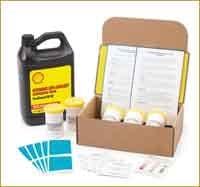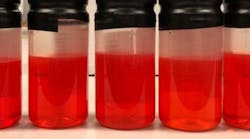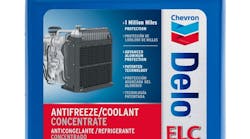The makers of Shell Rotella ELC Extended Life Coolant recently introduced, for general use, a coolant-conversion kit, which is designed to change a system using fully formulated conventional antifreeze into a system using "extended-life coolant." Among the potential benefits of making the conversion, says Shell, are lower maintenance costs, improved heat transfer, improved water-pump-seal life and effective long-term protection of all engine metals. Once converted to extended-life coolant (ELC), a diesel cooling system can operate 600,000 miles or 12,000 hours before being drained and refilled.
Maintenance of ELC involves adding an "extender package" at 300,000 miles or 6,000 hours, along with periodic checks of the coolant's freeze point and physical appearance. Properly maintained, says Shell, ELC typically lasts two to three times longer than fully formulated conventional coolant, which must be periodically treated with supplemental coolant additives (SCA). The SCA package is required, primarily, to ensure adequate concentrations of nitrite (or nitrite and molybdate) for resisting the pitting (cavitation) of wet cylinder sleeves.
Although Shell's Rotella ELC antifreeze also contains nitrite as a secondary inhibitor (which is reinforced with the extender package), the antifreeze's basic additive formulation is based on "organic acid technology" (OAT). More specifically, it is a "carboxylate-inhibited" antifreeze, which typically is characterized by the use of two chemicals—2-ethyl hexanoic acid and/or sebacic acid.
The additive package in Shell's Extended-Life-Coolant Conversion Fluid is identical to that in its ELC antifreeze. Each gallon of the conversion fluid is a 50/50 mix of super-concentrated additives and ethylene glycol. Assuming that a fully formulated conventional system is a good candidate for conversion, one gallon of the conversion fluid treats a 12-gallon cooling system. Before pouring in the conversion fluid, however, Shell recommends checking the existing coolant's freeze point (with a refractometer), its nitrite concentration and its pH (its acid/base characteristics). The latter two checks can be performed with paper test strips furnished with the conversion kit.
If the checked parameters fall within recommended ranges, then the conversion can continue, says Shell, with the replacement of the system's SCA filter (if used) with a non-additive filter. Once the system has been pressure tested and suspect hoses replaced, a gallon of coolant can be drained from the system and the conversion fluid added. After the engine has run for an adequate time, Shell asks the user to collect a sample in the furnished bottle and send it along for analysis to confirm a successful conversion. If this check is okay, then Shell says to top off the system when required with its Rotella ELC Extended Life Coolant.
Just to give you a more complete picture of cooling-system conversion, at least two other manufacturers promote the technique.
For example, Old World Industries (OWI), a leading manufacturer of antifreeze (both under its own label and other brand labels), makes a conversion fluid based on the technology of its Final Charge antifreeze. Final Charge, says OWI, is an extended-life product with an additive package based on organic acids, but not carboxylates, and containing no inorganic inhibitors. Fully formulated conventional systems can be converted to extended-life systems, says the company, via a procedure that entails use of a Final Charge converter fluid, then top-offs with Final Charge. Existing extended-life systems using different organic-acid technology can be converted, says OWI, by topping off with Final Charge antifreeze.
If you want to go the other way, that is, convert from a carboxylate-inhibited, extended-life system that contains nitrite, to a fully formulated conventional system, Penray has a procedure. Penray, a manufacturer of antifreeze additives, says that converting a "nitrited-organic-acid-technology" coolant involves adjusting the freeze point, draining about 30 percent of the system's volume, replacing drained coolant with a 50/50 mix of a fully formulated conventional antifreeze and water, then adding a good SCA package in an approximate 3-percent concentration. The only qualifier, says Penray, is that the extended-life coolant being converted not be too old. An advantage of this conversion, says the company, is that the system can be maintained with fully formulated conventional antifreeze, which is widely available.
Before converting cooling systems one way or the other, however, you'd be well advised to first consult the manufacturer of your truck or machine about your intentions.





